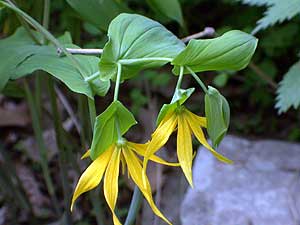|
Audio
Photos
Resources
Your Voice
|
Deer: the new eco-threat
July 7, 2004
 |
| Largeflower bellwort (Uvularia grandiflora) is one of the wildlfowers declining at many of the sites studied by University of Wisconsin resarchers. (Photo courtesy Dave Rogers, UW Herbarium) |
Duluth, Minn. — Most Minnesota gardeners know deer are good at mowing down hosta, tulips and other favorite plants. In the woods, deer munch on the small plants that live on the forest floor. Plants like orchids, lilies, and other wildflowers.
Fifty years ago, researchers at the University of Wisconsin surveyed hundreds of acres in the state, and made careful records of the plants on those sites. In the last couple of years, two biologists went back to many of those same sites and counted the plants living there now.
 | |||
Tom Rooney says at most sites they found fewer different kinds of plants.
"It tends to be the same species occurring over and again on the site," Rooney says. "You're losing the rare species, and picking up more and more common species."
Rooney says they tried to link the decline in rare species to the fact that the forest is getting older. But they found no evidence for that. Instead, lead researcher Don Waller says the evidence points to deer, which have increased dramatically in number over the last 50 years.
"The worst changes we've seen, ironically, were in a couple of state parks and a protected natural area, that showed losses of half or more of their plant species in 50 years," Waller says. "However in these sites, no deer hunting -- implying high densities of deer -- may be causing a lot of the effects we see in woods."
 | |||
Plants that rely on insects for pollination declined more than other types of plants. Waller thinks it might be because the insect-pollinated plants have showy flowers, which could catch they eye of a wandering deer. As the flowering plants decline, the insects that rely on them for food could decline as well -- bees, moths, butterflies, and hummingbirds.
Waller says it's worrisome because scientists don't know how particular insects and plants work to support each other.
"As we're losing parts of the ecosystem, we're not really sure what their full function is," Waller says. "They might play some crucial role we're not aware of, and only too late might we become aware of the fact that this loss led to an unraveling, or threats to other species."
Waller says the only places they studied that still have a healthy diversity of plants are on Indian reservations. You have to travel all the way to the Menominee Tribal Forest in northeastern Wisconsin to find a forest like it used to be 50 years ago.
In this forest, there are only about 10 deer per square mile. That's about as low as the deer population gets in Wisconsin.
 | |||
Don Reiter, the tribe's wildlife manager, says the deer population is low because the tribe manages the forest in such a way as to preserve several different ecosystems.
Deer find lots to eat in young aspen woods. There's less for them to eat where pines and oaks and maples grow. In the 360 square miles of the Menominee forest, there's really four different types of woods.
"We have pulpwood, we have northern hardwoods, white pine, red pine," Reiter says. "And in the forest ecosystem as a whole, there's plenty of food out there for the deer."
And because there aren't too many deer, young pines and hemlocks -- and orchids and lilies -- have a chance to grow.
State wildlife officials have been trying to thin the deer herd for several years.
 | |||
In Minnesota, hunters are shooting four times the number of deer they shot 50 years ago.
Steve Merchant, a forest wildlife program consultant for the Minnesota DNR, says the agency has liberalized its rules to encourage hunters to kill even more deer. But the number of hunters hasn't gone up in recent years. And lots of private land is posted against hunting.
"We need to have some help from people," Merchant says. "People still need to get out and hunt deer, and landowners need to provide that access for people to harvest deer."
Merchant says Minnesota is gradually trying to restore pine forests, which could cut down on the deer population.
"But as long as we still have the strong demand for aspen markets that we do, and we manage those aspen forests in a productive manner for wood fiber, we're going to create lot of good white-tailed deer habitat," Merchant says.
Merchant says it would take decades to change the woods enough to reduce the deer population. And in the meantime, we're losing more and more of the rare flowers.
|
News Headlines
|
Related Subjects
|
